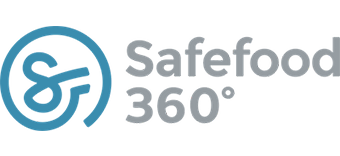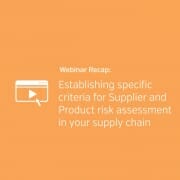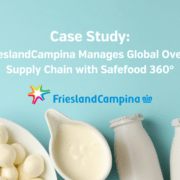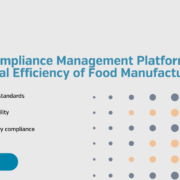Why Supplier Approval Programs Require Intelligence
The older that I get, the more that I realize I have started to become the person that I never wanted to be.
One that tells stories that start with “When I was your age….”.
All too often I find myself telling one of my children a story that begins with that phrase, only to realize that they haven’t stopped their game of Fortnite long enough to realize that I was telling them a story which I felt was important!
During consultations with clients, I find myself using a similar form of phraseology that too often describes the old days when an Approved Supplier meant that they were the suppliers who took the plant manager golfing, provided the best swag, or was simply the lowest the bidder.
Quality and food safety was an afterthought and not the criteria that formed the basis of an actual risk assessment to be carried out.
The major difference between the discussion with my children and the discussion with a customer is that I typically substitute “20 years ago…” in place of “when I was your age…”.
The ‘olden times’ of Supplier Approval Programs
What was it like 20 years ago, anyway?
There is an entire generation of new Quality Managers who find it impossible to believe that a Supplier Approval program was ever anything less than a migraine-inducing activity required in order to keep our GFSI auditor happy.
20 years ago, we had Approved Suppliers, and if we put them on a list I suppose you could argue that it technically was the Approved Supplier list.
It didn’t seem to be very difficult to get on that list.
20 years ago, we had Approved Suppliers, and if we put them on a list I suppose you could argue that it technically was the Approved Supplier list.
These lists were generally made up from the names of the suppliers who the procurement department had already been utilizing, and they went through all the trouble of entering their names into the computer, so…they are the approved supplier!
As difficult as it may be to believe, there wasn’t much more that qualified a supplier in order to make it onto that list.
Over a working-lunch one day, a colleague of mine tried to explain that a particular supplier was listed as an approved supplier because the company we worked for had been doing business with them for nearly 40 years.
There was no hint of food safety qualifications or a guarantee of a continued focus on quality. We were happy to continue to do business with them because we had been for several decades now, and besides, they sponsored an annual golf tournament that was amazing!
Our current reality of Supplier Approval
Since then, times have certainly changed.
During the last decade, we started to see the winds of change sweeping through this particular aspect of food safety as GFSI was introduced in North America.
Since then, the requirements have only ever increased, and the demands of our customers simply won’t allow us to do business on a handshake and a promise anymore.
the demands of our customers simply won’t allow us to do business on a handshake and a promise anymore.
A science-based, risk assessment approach must be taken.
Approval can’t be gifted to a supplier covering a raft of ingredients either.
These risk assessments need to be individualized to ensure we have properly assessed (and addressed) the risk for a specific material, from a specific manufacturing facility, of a specific supplier.

The scope of the Risk Assessments has increased to include Suppliers, Facilities, Agents/Brokers, 3rd Party, Raw Materials, and Products. A proper Supplier and Material Risk Assessment should follow a basic format:
The Risk Assessment we carry out should be criteria-based, and not simply a matrix to determine the probability and severity of a hazard.
All of this should be carried out in an efficient manner so that the data can be shared with the rest of your supply chain.
With the added requirements to ensure food safety throughout the supply chain, it is necessary that we have this data presented to us intelligently, and in real time, so that we can make the appropriate ongoing decisions to improve quality, safety, and efficiencies.
At this year’s Safefood 360° Connect user conference, we heard Dr. Darin Detwiler explain how the concept of blockchain enables a food manufacturing company to track their product from farm to fork, and how ideas such as blockchain are a necessity as food safety managers take on the Herculean effort to prevent foodborne illnesses within the supply chain.
What can the future of Supplier Approval look like?
Here at Safefood 360° we have a unique perspective on the emerging needs that are under the umbrella of Supply Chain Management and we are busy providing the tools our clients will need in order to have an intelligent look at their supply chain in real time and accurately predict the hazards which must be controlled.
At the end of a meeting, my boss often leaves me with a quote from Shakespeare or another great thinker from history. As much as I’d love to do the same, the most appropriate quote that I can think of is from the movie Back to the Future:
Marty McFly: Hey, Doc, we better back up. We don’t have enough road to get up to 88.
Dr. Emmett Brown: Roads? Where we’re going, we don’t need roads.
Okay, now that I think of it that really doesn’t have anything to do with helping you approve and manage your suppliers, map your supply chain, or predict food safety risks.
Quite honestly though, when I was your age, we didn’t need witty quotes to make a story impactful. Much like controlling today’s supply chain, we simply rolled up our sleeves and got to work!
What tools are you going to use to improve the way that your company handles supplier quality management? If you’re interested in learning how you can obtain the best tools available, contact us and request a demo!
We’ll be more than happy to show you!











Leave a Reply
Want to join the discussion?Feel free to contribute!